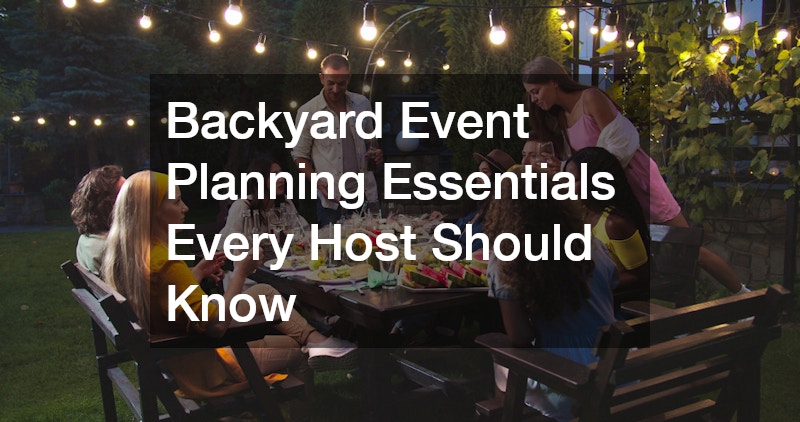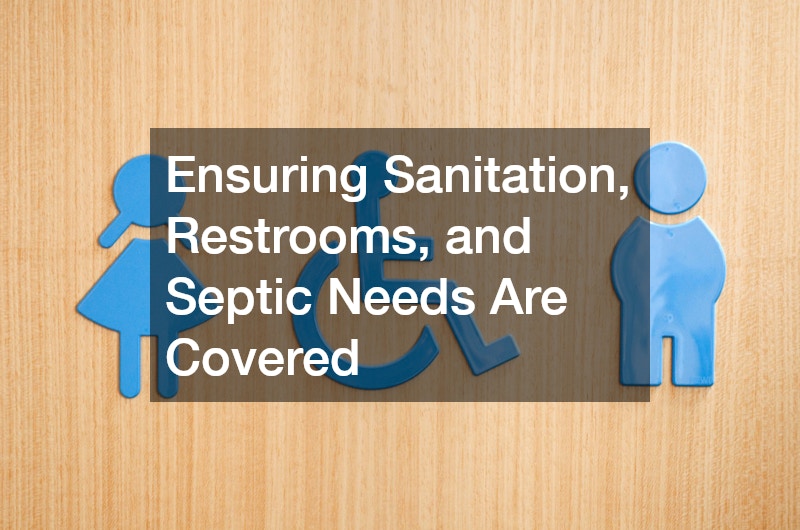Hosting a memorable gathering at home brings people together in a warm, welcoming setting that feels personal, festive, and comfortable. Whether you’re preparing a celebration for friends, a milestone party for family, or a casual get-together for neighbors, the key to success lies in planning thoughtfully. Outdoor gatherings offer a unique atmosphere because they blend the comfort of home with the natural beauty of the yard, creating an experience that feels both relaxed and intentional. As more people choose the convenience and charm of hosting from home, understanding the core steps of outdoor preparation becomes essential. From layout and design to food, facilities, and cleanup, every detail contributes to the overall flow of the event. When you approach the process with structure and creativity, you can transform an ordinary yard into a functional, stylish space suited for gatherings of any size.
This guide outlines the foundational strategies and considerations every host should know before preparing for a backyard event. Planning not only enhances guest comfort but also reduces stress, allowing you to enjoy the experience as much as your visitors. With a thoughtful approach and a focus on both the practical and the aesthetic, you can create a gathering that feels seamless, welcoming, and unforgettable.
Creating a Well-Organized Layout That Enhances Flow
A carefully planned layout is the backbone of any successful backyard event because it dictates how guests move, interact, and enjoy the space. When people arrive, they should feel comfortable navigating your yard without confusion or crowding, and that starts with the intentional placement of every major element. Begin planning by taking stock of your available space and identifying the areas with the most natural flow. Paths should be spacious and unobstructed, stepping surfaces should be clear, and major stations—like food, drinks, seating, and entertainment—should be easily accessible.
To create separation without restricting movement, consider dividing your yard into zones with a purpose. A dining section positioned near shade or seating encourages easy conversation, while a standing or mingling zone closer to high-traffic areas prevents congestion around tables. If children will be attending, designating a play zone in a visible yet separate area ensures they’re safe and entertained without getting underfoot. The type of gathering may also influence your layout: casual events benefit from open seating clusters, while structured gatherings may require assigned tables, defined dining areas, or a central feature like a buffet or drink station.
Lighting should also be factored into your layout, especially for evening events. Strategically placed string lights, pathway markers, or lanterns add ambiance while preventing accidents and making the yard easier to navigate. You may also want to incorporate décor elements such as floral arrangements, garden accents, or themed décor that connect each zone visually.
Weather preparation is a critical part of layout planning. Identify sunny areas to avoid placing food stations there, plan for wind direction when arranging decorations, and watch for areas that may become slippery if wet. Seating should be stable on grass or patio surfaces, and tables should have enough space between them for guests to move comfortably. The goal is to make the environment intuitive and enjoyable so your backyard event feels polished, well-structured, and inviting from every angle.
Enhancing Visual Appeal Through Stylish and Functional Outdoor Design
Creating a visually appealing environment elevates the entire experience of your gathering and makes your backyard event feel intentional and thoughtfully curated. Start by identifying the natural strengths of your yard—perhaps a garden bed, a deck, a patio, or mature trees—and highlight them with subtle decorative touches. Adding comfortable seating, soft lighting, or floral accents helps create an inviting mood. Consider the mood you want to establish: relaxed and cozy, bright and energetic, elegant and refined, or playful and casual. Once your theme is clear, décor decisions become much easier.
A practical yet beautiful design approach includes using elements that serve both aesthetic and functional purposes. For example, outdoor rugs soften the ground while creating structure for conversation areas. Lanterns or solar walkway lights enhance ambiance while guiding guests safely along pathways. Natural greenery can be enhanced through a visit to a local garden center, where you can find supplemental flowers, shrubs, or potted plants to fill visual gaps and brighten the space.
When decorating for your backyard event, consider height, texture, and layering. Tall elements like hanging lights or pergola drapes draw the eye upward, while low-set décor such as candles or tabletop arrangements add warmth. Fabrics such as table runners, weather-resistant cushions, or lightweight throws introduce texture and depth to the overall design. Even simple changes—like adding chair covers, arranging decorative lanterns, or incorporating thematic color palettes—can transform your space into something memorable and cohesive.
Functionality remains a priority. Make sure decorations don’t block pathways or impede seating. If you’re using flowers, ensure they can withstand outdoor temperatures. And if your gathering extends into the evening, test all your lighting to make sure it’s bright enough but not harsh. A well-designed outdoor space enhances guest comfort while adding character to your backyard event, ensuring it feels polished and inviting from start to finish.
Managing Weather-Related Challenges With Smart Preparation
Every backyard event is subject to the unpredictability of weather, making proactive preparation essential for guest comfort and overall event success. Start by checking the forecast throughout the days leading up to your gathering, but keep in mind that outdoor conditions can change rapidly. With this in mind, it’s wise to prepare for sun, wind, and unexpected rainfall even if the forecast appears clear.
Shade is one of the most important components to consider, especially during daytime events. Exposure to direct sunlight can quickly become uncomfortable, particularly during warmer months. To address this, many hosts rely on pop up canopy services, which provide temporary structures that give guests a cool, shaded retreat. These canopies not only shield guests from sun and light rain but also enhance the visual structure of your outdoor space by creating defined gathering areas.
Temperature fluctuations also require attention. If your event continues into the evening, portable heaters or fire pits help keep guests warm. For daytime gatherings, cooling fans, water mist sprayers, or strategically placed shade cloths contribute significantly to comfort. Wind can affect everything from décor to food placement, so secure table coverings, stabilize lightweight items, and avoid decorations that might easily topple.
Ground conditions matter as well. Areas that become muddy or slick after rain should be avoided for seating or food stations. If you anticipate moisture, consider laying down outdoor mats or using elevated platforms to keep surfaces dry and safe. In windy or unpredictable weather, avoid using décor that can blow around easily.
Your goal is to ensure guests feel comfortable regardless of changing conditions. By planning for sun, wind, and rain, you reduce the chance of last-minute disruptions and give yourself options if the weather shifts unexpectedly. This level of preparedness ensures that your backyard event stays enjoyable and stress-free, no matter what nature decides.
Providing Thoughtful and Convenient Food and Beverage Options
Food is often the centerpiece of any gathering, making thoughtful planning essential for hosting a smooth and enjoyable backyard event. When selecting menu options, consider the size of your crowd, dietary preferences, and ease of service. Simplicity is often best, but simplicity doesn’t have to sacrifice quality. You want dishes that are easy for guests to eat outdoors and simple for you to maintain.
A popular solution for effortless catering is partnering with box lunch caterers, who provide pre-portioned meals for guests. These boxed meals offer convenience, reduce line congestion, and simplify cleanup. They are especially effective for events with mixed age groups or guests who prefer individually packaged items. For more interactive experiences, you may also choose buffet-style dining, grilling stations, or themed food bars that encourage movement and conversation.
The food setup should be accessible yet separate from high-traffic zones. Tables should be sturdy, level, and shaded from direct sunlight to protect food quality. Drinks should be placed in a different area to reduce crowding. Providing multiple drink stations stocked with water, iced beverages, and optional themed cocktails improves flow and keeps guests refreshed.
Serving utensils, napkins, plates, and trash bins should be placed strategically near dining areas. If your event includes children, consider offering kid-friendly options like fruit cups, simple sandwiches, or snack trays.
Presentation matters too. Even casual meals feel special when arranged thoughtfully on attractive platters or displayed with coordinated table décor. The goal is to provide delicious food in a manner that feels effortless and well-organized, allowing guests to enjoy every part of your backyard event without confusion or inconvenience.
Preparing Your Outdoor Space With Safety and Cleanliness in Mind
Safety and hygiene play a major role in creating a comfortable environment for guests at any backyard gathering. Before the event, walk through your yard and identify potential hazards such as uneven pavers, loose stones, slippery surfaces, or protruding roots. Addressing these issues ahead of time helps prevent accidents and ensures guests can move freely throughout the yard.
Yard cleanup should include mowing the lawn, trimming bushes, and ensuring pathways are clear. If your property has aging trees or damaged limbs, consider consulting tree removal companies to eliminate hazards before hosting. Professional crews can also manage emergency trimming or clean-up tasks you may not feel comfortable handling on your own. When branches or overgrowth are not dangerous but overextended, tree services provide shaping and pruning that enhance safety while improving the appearance of your landscape.
Ensuring Sanitation, Restrooms, and Septic Needs Are Covered
One of the most overlooked aspects of outdoor hosting is restroom availability, yet it can dramatically influence guest comfort. If you’re hosting a larger gathering, your home’s indoor bathroom may not be sufficient. High-traffic use can strain plumbing, create long lines, and lead to unnecessary stress. That’s why many hosts turn to local portable toilet rental services, which provide convenient, sanitary solutions to support outdoor gatherings.
In addition to restroom availability, your home’s septic system must be considered if you live in an area that uses one. High guest volume can cause strain on aging systems, especially when gatherings last several hours. Before hosting, it may be wise to consult local septic tank cleaning services to ensure your system is functioning properly. Preventive maintenance reduces the risk of unexpected issues like backups or odors that could disrupt your backyard event.
In some cases, particularly on rural properties or for larger gatherings, homeowners also work with local septic companies for inspections or support services, ensuring the system can handle increased usage. These professionals can identify potential problems early and help you avoid emergencies during your event.
Handling Waste, Cleanup Logistics, and Post-Event Organization
Cleanup is a major part of outdoor hosting, and planning for it early makes the aftermath of your backyard event much easier to manage. Proper waste disposal prevents trash buildup, keeps pests away, and helps maintain your yard’s appearance during and after your gathering. While household bins may suffice for smaller events, larger gatherings benefit from renting from a local dumpster rental company, which provides a dedicated disposal container for trash, bulky items, and event waste.
Once the event ends, cleanup should follow a simple system. Begin by clearing tables, collecting decorations, and removing large items. Next, focus on waste disposal, ensuring all trash is placed in appropriate containers. After large debris is handled, sweep or blow pathways, clean surfaces, and inspect the yard for forgotten items. If furniture was moved or rearranged, return it to its original location to restore the yard’s layout.
Using Property Features and Outdoor Installations Strategically
Many homeowners enhance their event setup by incorporating decorative or structural elements that add texture, organization, and durability to the space. Features like patios, walkways, and seating areas play a major role in improving both aesthetics and functionality. Incorporating hardscaping into your yard—but only using it once here—can create long-lasting surfaces that withstand heavy foot traffic, making gatherings smoother and more comfortable.
When planning your backyard event, consider how your existing structures can enhance the experience. A patio can serve as the main dining area, a deck can become the entertainment hub, and stone pathways can guide guests effortlessly through different zones. Outdoor seating walls, fire pits, or paver platforms provide stability and charm, reducing the reliance on temporary furniture.
If you have water features, garden beds, or pergolas, incorporate them intentionally into the event’s layout or décor theme. A pergola, for example, can serve as a focal point where you place a drink station or dessert display. Garden beds can frame seating areas with natural color and warmth. Even simple features like outdoor benches or raised planters help build structure and organization.
Strategically integrating your outdoor features ensures your backyard event feels sophisticated and well-designed. Think of your yard as a canvas where each element contributes to the overall atmosphere, guiding guests through a cohesive and inviting experience.






